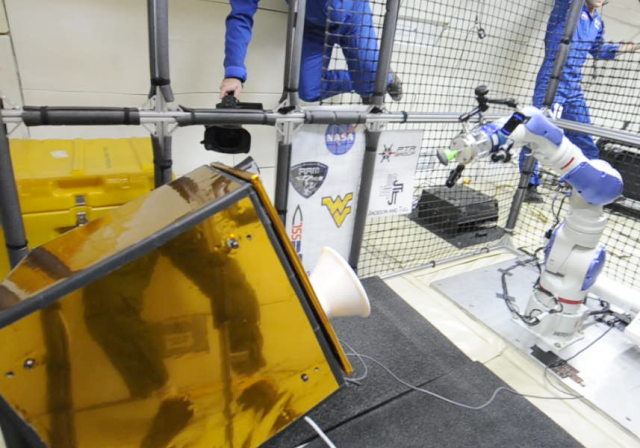The Robotics Demonstration and Test team, in the NASA Goddard Satellite Servicing Capabilities Office, used the Orocos ecosystem to control a Motoman SIA10D industrial robot to demonstrate autonomous visual tracking of both cooperative, and uncooperative, targets in microgravity.  NASA robot visually tracking a free-floating, non-cooperative target
NASA robot visually tracking a free-floating, non-cooperative target
Robotics
Using Orocos to visually track a free-floating target in micro-gravity
| Submitted by snrkiwi on Sun, 2011-09-18 19:33 |
»
- Login or register to post comments
- See complete post...
Dynamic parameter identification of a robot and its payload
| Submitted by Wilm Decre on Wed, 2011-01-26 09:38 |
»
- Login or register to post comments
- See complete post...
Constraint-based motion specification application using two robots
| Submitted by Tinne De Laet on Thu, 2008-07-24 16:49 |
The ACM research group of the K.U.Leuven used Orocos Real-Time Toolkit as framework for an involved robotics application as well as Orocos Bayesian filtering library and Kinematics and Dynamics Library as detailed in this paper.
The experiment consists of a complex task—“human-aware task execution”—involving two robot arms, five PCs interconnected by ethernet, and half a dozen or so sensors.
»
- Login or register to post comments
- See complete post...
Robotics links
- RACK, the Robotics Application Constructions Kit provides a middleware to ease and standardise the development of industrial and academic control software for robots. Specifically, it aims at supporting mobile service robot scenarios. RACK's real-time components are implemented in C++ and make use of the real-time services provided by Xenomai. Non-real-time components concentrate on GUI elements which are implemented in Java, and extending this support to Linux C/C++ applications is
»
- Login or register to post comments
- See complete post...
